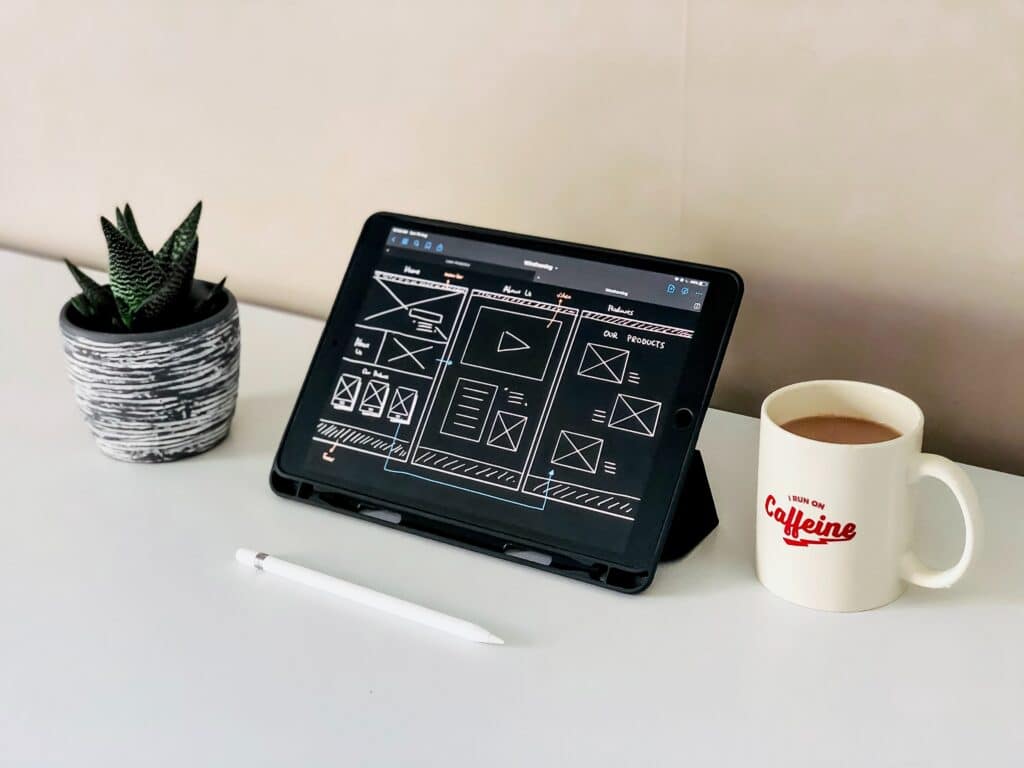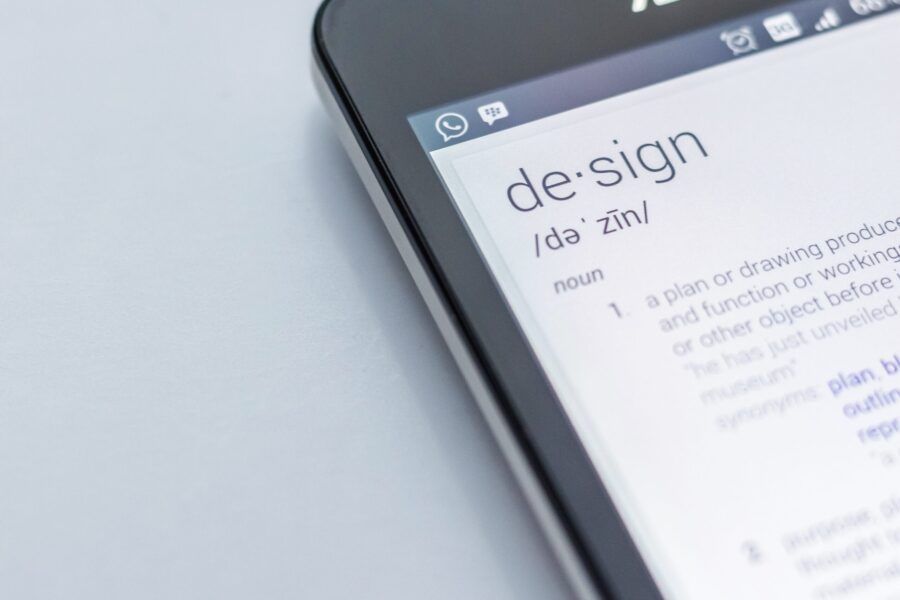Designing a website can be a daunting task, especially if you’ve never done it before. With the right guidance, however, you can create an amazing website that fulfills its reason for existence—showcasing your projects, telling your unique story, and offering your services to viewers in an attractive, engaging way.
Here, we focus on providing a step-by-step guide on how to design a website. We’ll cover topics such as layout, fonts, images, navigation, and loading speed, as well as what you can do to enhance user experience, and get your site found on search engines.
But before we dive into the how, let’s touch on the why.
Why good website design matters
Good website design is essential for making a good impression and providing a great user experience. A well-designed website conveys credibility, trustworthiness, and showcases your brand. It should also be easy to navigate while providing your visitors with the information they need to know.
Good web design versus bad web design
Good web design should be “clean,” with an aesthetically pleasing layout. The font should be professional, easy to read, and the images should be high-quality and relevant. The navigation should be straightforward and intuitive; and as a whole, the website and each page should load quickly.
Bad web design, on the other hand, is often frustrating. A sign of a bad website includes visitors giving up trying to find what they need because it’s just too difficult. These sites tend to look untidy and outdated, with clashing colors and cluttered fonts.
What are the 7 major steps to designing a website?
- Define your website goals: Identify your website’s purpose and target audience.
- Choose your website platform and design elements: Select a platform to use and design elements such as color schemes and typography.
- Plan your website structure and layout: Create a website wireframe and organize your website’s content.
- Design your website pages: Design consistent pages for the homepage, about page, and product or services page.
- Optimize your website for user experience and SEO: Improve website loading speed, navigation, and content structure.
- Test your website and launch: Conduct website testing and prepare for launch.
- Keep the website up to date: Make sure to check for any broken links or outdated content, and make updates or changes as needed.
Want a good website? Keep reading.

Define Website Goals
The first step in designing your website, or a website for any client, is to define your goals. Knowing exactly what function the website needs to serve will help you create a successful site.
Defining goals before designing a site will help guide you throughout the entire process. For example: If your client’s goal is to create an online store, you’ll want to make sure the design you create is optimized for selling products.
Tips for identifying a website’s purpose
- Ask yourself (or your clients) what type of website you want to create, and what your goals are for having one.
- What is the purpose of the website? Is it to provide information, sell products, or promote a service?
- Do they want to create an online community around a specific topic, or just provide visitors with relevant news and updates?
- Identify the target audience. Who do they want to attract to their website?
- Consider how long they would like to keep the website running, and how they’d want it run.
- If they haven’t already, recommend they create a budget and decide how much they are willing to spend on design and development.
By following these tips, you’ll be able to define a website’s purpose and target audience, which will make it easier to design a website that looks great while actually meeting your client’s needs.
Choose Your Website Platform and Design Elements
After you’ve determined your website goals, you’ll need to decide on a platform to build your website. Several website building platforms are available, and they all have their own advantages and disadvantages.
Here’s a list of various website platforms available, and what each offers:
- Format: A portfolio website platform built with photographers, designers, artists, filmmakers, and other creative professionals in mind. Format offers clean, modern portfolio templates that help you showcase your best work with minimal setup and look great on mobile devices. It also includes an online store for selling your work, client management tools through Workflow, and a worldwide Prints Marketplace.
- WordPress: Easy to use, this website-building platform offers lots of tutorials to get you started (even with no experience!). With thousands of plugins available, there’s no coding required to build your own solid, beautiful corner of the world.
- Shopify: Ideal for creating e-commerce websites, Shopify offers lots of pre-made themes that you could then customize for your own store.
- Joomla: Another popular platform, Joomla offers various features and customization options for setting up a simple yet elegant website
- Drupal: Coming with a powerful content management system, Drupal offers a variety of features and customization options.
- Squarespace: Squarespace is easy to use and offers lots of templates and customization options, and integrates with various third-party services.
How to choose the best website platform for your needs
Each website platform offers something different. To pick the best one for you, consider the purpose of your website, your budget, and the time you have available to work on it. It’s also important to think about the features you need and the level of customization you want.
When deciding on a website platform and design elements, you’ll also need to look into hosting. Your hosting provider stores your website files and ensures the website is accessible to visitors who explore the web. You can either choose a shared hosting plan or a dedicated hosting plan, which, while more expensive than a shared one, offers more features and customization.
- Consider what type of website you are creating and what goal you want to achieve.
- Do your research on the different website platforms and decide which one best meets your needs.
- Make sure that the platform you choose is user-friendly and easy to use for yourself.
- Check to see if the platform offers the features you need for your website.
- Read reviews of the platform and compare prices to make sure it’s the best choice for you.
Which software is best for web design?
There are several popular web design software programs, including Adobe Dreamweaver, Adobe Photoshop, and Sketch. Each of these software programs offers different features and user experiences, so it is important to evaluate which one best meets your design goals and comfort level. For those just starting out, Adobe Dreamweaver and Photoshop are both good choices as they are user friendly and provide plenty of tutorials and help. For the more experienced user, Sketch is a great choice for designing mobile websites.
How can I design a website for free?
There are a few free website design options to consider, such as WordPress, Wix, and Weebly. Each of these options offer free plans that allow you to design and manage your own website. Free website design templates are available from many online sources, and can be used to create a website.
How to select website design elements
Once you’ve chosen your website platform and hosting provider, it’s time to select the design elements for your website. This includes selecting a color scheme, typography (aka font), and images.
When selecting a color scheme, you’ll want to use colors that match the overall theme and purpose of your website. You’ll also want to choose colors that are pleasing to the eye and don’t clash with each other.
For typography, consider the fonts and characteristics you want, such as serif or sans-serif, and the size and style of the text. It’s important to choose fonts that are easy to read and legible on all devices.
Finally, pick high-quality images that tie in with your website’s theme. For example, if your website is about travel, you’ll want to use pictures of beautiful locations and vibrant landmarks. Make sure the images are not too big and not too small, make sure they’re just right!
Tips for selecting design elements
- Choose colors that match the purpose and theme of your website.
- Use fonts that are easy to read and legible on all devices.
- Select images that tie in with your website’s theme.
- Make sure the design fits with the overall look and feel of your website.
- Test out different color schemes, fonts, and images to see what looks best.

Plan Your Website Structure and Layout
The next step in the web design process is to plan your website structure and layout. This is a critical step, as the structure of your website will determine how visitors can find the content they’re looking for.
Getting the layout figured out should come before the design itself; after all, the design needs to match the layout. You could have the most beautiful design but if the layout is clunky, unclear, and inefficient, all that fancy color palettes and typography won’t help.
The website structure should be intuitive and easy to navigate. Make sure there are clear pathways between pages, and that each page is clearly labeled. You’ll also want to include a search bar on the website, so visitors can quickly search for the content they need.
When planning the structure and layout of your website, keep these tips in mind:
- Choose an intuitive website structure that is easy to navigate.
- Include a search bar to help visitors find what they are looking for.
- Make sure the navigation is easy to find and use.
- Make sure all buttons and links are clearly labeled.
- Ensure the page loads quickly for a better user experience.
What’s a website wireframe?
When planning the layout of your website, you’ll also want to create a website wireframe. This “wireframe” isn’t made out of physical metal wires, of course—we’re talking about a blueprint or a map of your website’s structure which helps you plan the layout and design of the page before you get started.
A wireframe is a great way to visualize the structure of your website and help you decide where to place different elements. It’s also a great tool for communicating with developers, designers, and other people in your team.
Creating a wireframe is a simple process. You can use a wireframing tool like Adobe XD, Figma, or Sketch, or you can create a wireframe the old fashioned way, by hand. The important thing is to include all the elements that you want to include on your website, such as navigation, content, images, and videos.
Tips for creating a website wireframe
- Use a wireframing tool to create a visual representation of your website.
- Include all the elements you want on the website, such as navigation, content, images, and videos.
- Make sure the wireframe is clear and easy to understand.
- Clearly label each element on the wireframe.
- Use a grid-based layout to help keep everything organized and consistent.
How to organize your website’s content
Once you’ve decided on the structure and layout of your website, it’s time to start organizing the content. This includes text, images, videos, and other media.
Organizing your website’s content can help keep your website looking organized and professional. You’ll want to create a clear hierarchy and make sure the content is easy to find.
You’ll also want to make sure your content is formatted properly. This includes using headings, subheadings, and bullets to make the content easy to scan. Of course, you’ll also need to proofread the content to make sure it’s error-free.
Tips for organizing website pages
- Create a clear hierarchy for your website’s content.
- Format the content properly for better readability.
- Use headings, subheadings, and bulleted lists to make the content easy to scan.
- Make sure the content is easy to find and navigate.
- Proofread the content to ensure it’s accurate and error-free.
- Categorize the content so it’s easier to find.
Design Your Website Pages
The final step in creating a website is to design the pages. This is the fun part—you’d finally get to add colors, typography, and images to your website.
When designing your website pages, you’ll want to make sure the design matches the structure and layout you planned out earlier. You’ll also want to use colors and fonts that match the overall theme and purpose of your website.
When selecting colors, you’ll also want to avoid using too many colors as it can make the page look cluttered and unorganized. Instead, pick a few colors that work well together and stick to them.
The same goes for fonts. You want to use fonts that are easy to read, legible on all devices, and match the overall look and feel of your website.
The importance of consistency in website design cannot be understated. Consistent design across the entire website will create a better user experience, a sense of cohesion and elegance within the entire site, and an overall sense of professionalism and trust. On top of all that, consistent design makes it easier for visitors to find the content they are looking for.
Can I teach myself web design?
Yes, web design can be self-taught. Learning the basics of HTML and CSS is a great place to start. There are many online tutorials and videos available to guide you through the process of creating a website. Once you have learned the basics, you can focus on more advanced topics such as JavaScript, advanced styling, and website optimization. With dedication and practice, you can become an expert web designer.
What are the 3 types of web design?
The three main types of website design are static, dynamic, and adaptive. Static websites are designed with predefined pages, meaning the content and layout remain consistent no matter which device is used to view the website. Dynamic websites feature content and layout changes based on user interactions, while adaptive websites are designed to update the content and layout based on the device being used to view the website.
Tips for designing specific website’s pages
Let’s take a quick break from the big picture, and focus on the core individual pages of your web design portfolio site–which can easily translate to pages in websites you design for others:
Homepage:
- Keep the design simple, with a focus on the central message you want new visitors to see—a new project you’re offering, what services you’re offering, what you’re all about as a professional, etc.
- Use a big, bold header or logo to make an impact.
- Include a clear call-to-action to help visitors take the desired action.
- Choose a color scheme that matches your website’s theme.
- Take advantage of visuals like illustrations, images, and videos to grab the visitor’s attention.
- Include a sign-up form to capture visitor’s information.
Portfolio pages:
- Curate about 10-20 examples of your best work to showcase in your portfolio.
- Depending on the scale and effort involved in an individual web design project, consider showcasing projects individually, succinctly highlighting the parameters of the design request and including process examples along with the final result.
- Create separate portfolio pages for different types of work (for example, web design, illustration, & graphic design would each be in a different page.)
- Include a CTA or button linking to your contact page, making it easy for interested potential clients to reach out after viewing your portfolio.
About page:
- Include a brief description of your company and its mission.
- As you format text, keep to concise, scannable paragraphs for better readability.
- Focus on using visuals, like images and videos, to tell your story.
- Highlight key team members.
- Include any awards, press, or accolades your company has received to build trust and authority.
- Showcase customer testimonials, or any client notes about their experience working with you.
Product or Services page:
- Include compelling descriptions of your products or services.
- Showcase images and videos of your products or services in action.
- Provide helpful information like pricing and availability.
- Include customer reviews to build trust, if available.
- Highlight any special offers or discounts.
Optimize Your Website for User Experience and SEO
So now you’ve got the layout and web design down. But how are you going to get found?
That’s where SEO (search engine optimization) and UX (user experience) come in. Optimizing your website for SEO and UX will help to ensure that your website shows up in the search results and that visitors have a good experience on your website.
What is UX?
User experience (UX) design is the process of creating features, functions, and content on your website that are designed to make it as easy and enjoyable as possible for users to interact with and navigate through. UX design focuses on creating an interface that is intuitive and user-friendly, while also aiming to create an engaging and enjoyable experience for users.
What is SEO?
Search engine optimization (SEO) is the process of increasing the visibility of a website in search engine results. SEO involves optimizing the website’s content and coding in order to make it easier for search engines to find and index the website’s content. SEO also involves optimizing the website’s usability and user experience in order to make it easier for users to find the information they are looking for.
Tips for improving website loading speed, navigation, and content structure
- Optimize images for load speed.
- Choose the right hosting option for your website.
- Use caching, compression, and other performance enhancing techniques.
- Make sure the navigation is easy to use and allows visitors to quickly find the content they’re looking for.
- Structure your content in a logical order and use headings, subheadings, and bullets to make it easier to scan.
- Include internal links to help visitors navigate your website.
Test Your Website and Launch
Once you’ve created your website, you’ll want to test it to make sure it’s working as expected. This includes testing links, forms, payment processing, and other features.
You’ll also want to test the website across different browsers and devices to make sure it looks and works the same on all platforms. Testing your website helps to ensure that everything is working properly and all the features are working as intended. Testing across different browsers and devices makes sure your website looks and works the same on all platforms. Launching on a reliable hosting platform and ensuring DNS settings are correct helps to ensure your website is accessible to visitors.
Common website tests to run before launch:
- Link testing: Run tests to make sure all internal and external links are working properly.
- Performance testing: Test the page load speeds to make sure the pages are loading quickly.
- Compatibility testing: Test the website on different browsers and devices to make sure it’s looking and working the same across all platforms.
- Security testing: Make sure to test for common security vulnerabilities to keep your website and visitors safe.
- User testing: Ask a collaborator, friend, family member or mentor to look over your site. Ask them to complete a task on the site and see how they do navigating through it to see if you need to make any improvements.
Doing these website tests before launch helps to make sure your website is up to date and secure, and that visitors have a positive experience when they visit.
What to look out for when preparing a website for launch
- Make sure all links are working properly.
- Test the website performance across devices and browsers.
- Check for common security vulnerabilities and make sure that your website is secure.
- Double check the DNS settings and make sure they are correct.
- Test the payment processors and other features to make sure they are working properly.
- Perform a final check of the website to make sure it looks and works as expected.
Once this step is completed, you’ll be ready to launch your website and share it with the world!
Final thoughts: What’s your website going to look like?
Good website design matters. It helps to create an engaging experience for visitors, establishes trust, and can help you reach your goals. Good website design also requires optimization for SEO and UX, testing for compatibility, and a reliable hosting platform.
Creating a website from scratch can be daunting, but following the steps outlined in this guide can create an effective website that meets your goals and offers a great user experience.
Ready to take your newfound knowledge and put it into action? Use the step-by-step process shared in the article to design your own website (or two!), and then test, optimize, and launch them to share with the world.












